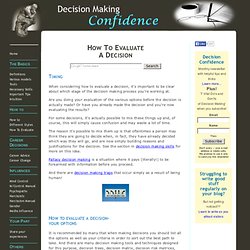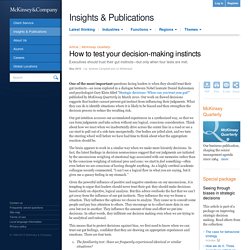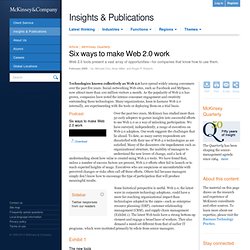

Andrew McAfee's Blog — The Business Impact of IT. How to evaluate a decision to avoid making poor ones. Timing When considering how to evaluate a decision, it's important to be clear about which stage of the decision making process you're working at.

Are you doing your evaluation of the various options before the decision is actually made? Or have you already made the decision and you're now evaluating the results? For some decisions, it's actually possible to mix these things up and, of course, this will simply cause confusion and may waste a lot of time. The reason it's possible to mix them up is that oftentimes a person may think they are going to decide when, in fact, they have already decided which way they will go, and are now simply building reasons and justifications for the decision.
Fallacy decision making is a situation where it pays (literally!) And there are decision making traps that occur simply as a result of being human! How to evaluate a decision-your options And basically the idea here is to make sure that you're making the best choice and avoiding negative consequences. On the origin of strategies - McKinsey Quarterly - Strategy - Strategic Thinking. The right way to hedge - McKinsey Quarterly - Corporate Finance - Performance. Hedging is hot.

Shifts in supply-and-demand dynamics and global financial turmoil have created unprecedented volatility in commodity prices in recent years. Meanwhile, executives at companies that buy, sell, or produce commodities have faced equally dramatic swings in profitability. Many have stepped up their use of hedging to attempt to manage this volatility and, in some instances, to avoid situations that could put a company’s survival in jeopardy.
When done well, the financial, strategic, and operational benefits of hedging can go beyond merely avoiding financial distress by opening up options to preserve and create value as well. But done poorly, hedging in commodities often overwhelms the logic behind it and can actually destroy more value than was originally at risk. Podcast The right way to hedge Hedge net economic exposure Keep in mind that net economic exposure includes indirect risks, which in some cases account for the bulk of a company’s total risk exposure. Exhibit 1 Enlarge. How to test your decision-making instincts - McKinsey Quarterly - Governance - Leadership. One of the most important questions facing leaders is when they should trust their gut instincts—an issue explored in a dialogue between Nobel laureate Daniel Kahneman and psychologist Gary Klein titled “Strategic decisions: When can you trust your gut?”

Published by McKinsey Quarterly in March 2010. Our work on flawed decisions suggests that leaders cannot prevent gut instinct from influencing their judgments. What they can do is identify situations where it is likely to be biased and then strengthen the decision process to reduce the resulting risk. Our gut intuition accesses our accumulated experiences in a synthesized way, so that we can form judgments and take action without any logical, conscious consideration. Think about how we react when we inadvertently drive across the center line in a road or see a car start to pull out of a side turn unexpectedly.
The brain appears to work in a similar way when we make more leisurely decisions. There are no universal safeguards. Six ways to make Web 2.0 work - McKinsey Quarterly - Organization - Change Management. Technologies known collectively as Web 2.0 have spread widely among consumers over the past five years.

Social-networking Web sites, such as Facebook and MySpace, now attract more than 100 million visitors a month. As the popularity of Web 2.0 has grown, companies have noted the intense consumer engagement and creativity surrounding these technologies. Many organizations, keen to harness Web 2.0 internally, are experimenting with the tools or deploying them on a trial basis. Podcast Six ways to make Web 2.0 work Over the past two years, McKinsey has studied more than 50 early adopters to garner insights into successful efforts to use Web 2.0 as a way of unlocking participation. Some historical perspective is useful. Web 2.0 covers a range of technologies. Earlier technologies often required expensive and lengthy technical implementations, as well as the realignment of formal business processes.
Gains from participation Management imperatives for unlocking participation 1. The promise of prediction markets: A roundatble - McKinsey Quarterly - Strategy - Strategy in Practice.